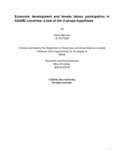Economic development and female labour participation in SAARC countries: a test of the U-shape hypothesis
Abstract
The paper explores whether there exists U shaped hypothesis among the 8 SAARC countries. It first looks at the SAARC nations by implementing the fixed effects model and then analyses the countries individually to see if the relationship between economic growth and the female labour force participation (FLP) holds. The U-shaped hypothesis states that when an economy is in the rudimentary stage of development, it experiences high rates of FLP; more women are involved in the agricultural sector. As the country undergoes transformation, the FLP falls. Finally, when the nation has embraced modern economy, more women join the labour market. Additionally, this paper also highlights the country specific barriers that prevent women from joining the workforce and gives policy recommendations that each of the South Asian economies can adopt to promote greater FLP.

